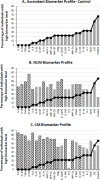Cytokine response during non-cerebral and cerebral malaria: evidence of a failure to control inflammation as a cause of death in African adults
- PMID: 27168977
- PMCID: PMC4860323
- DOI: 10.7717/peerj.1965
Cytokine response during non-cerebral and cerebral malaria: evidence of a failure to control inflammation as a cause of death in African adults
Abstract
Background. With 214 million cases and 438,000 deaths in 2015, malaria remains one of the deadliest infectious diseases in tropical countries. Several species of the protozoan Plasmodium cause malaria. However, almost all the fatalities are due to Plasmodium falciparum, a species responsible for the severest cases including cerebral malaria. Immune response to Plasmodium falciparum infection is mediated by the production of pro-inflammatory cytokines, chemokines and growth factors whose actions are crucial for the control of the parasites. Following this response, the induction of anti-inflammatory immune mediators downregulates the inflammation thus preventing its adverse effects such as damages to various organs and death. Methods. We performed a retrospective, nonprobability sampling study using clinical data and sera samples from patients, mainly adults, suffering of non-cerebral or cerebral malaria in Dakar, Sénégal. Healthy individuals residing in the same area were included as controls. We measured the serum levels of 29 biomarkers including growth factors, chemokines, inflammatory and anti-inflammatory cytokines. Results. We found an induction of both pro- and anti-inflammatory immune mediators during malaria. The levels of pro-inflammatory biomarkers were higher in the cerebral malaria than in the non-cerebral malaria patients. In contrast, the concentrations of anti-inflammatory cytokines were comparable in these two groups or lower in CM patients. Additionally, four pro-inflammatory biomarkers were significantly increased in the deceased of cerebral malaria compared to the survivors. Regarding organ damage, kidney failure was significantly associated with death in adults suffering of cerebral malaria. Conclusions. Our results suggest that a poorly controlled inflammatory response determines a bad outcome in African adults suffering of cerebral malaria.
Keywords: Cerebral; Cytokine; Inflammation; Malaria; Plasmodium falciparum.
Conflict of interest statement
The authors declare there are no competing interests.
Figures




Similar articles
-
Selected P. falciparum specific immune responses are maintained in AIDS adults in Burkina Faso.Parasite Immunol. 1996 Jul;18(7):333-9. doi: 10.1046/j.1365-3024.1996.d01-116.x. Parasite Immunol. 1996. PMID: 9229386
-
Evidence of IL-17, IP-10, and IL-10 involvement in multiple-organ dysfunction and IL-17 pathway in acute renal failure associated to Plasmodium falciparum malaria.J Transl Med. 2015 Nov 24;13:369. doi: 10.1186/s12967-015-0731-6. J Transl Med. 2015. PMID: 26602091 Free PMC article.
-
Parasite Recognition and Signaling Mechanisms in Innate Immune Responses to Malaria.Front Immunol. 2018 Dec 19;9:3006. doi: 10.3389/fimmu.2018.03006. eCollection 2018. Front Immunol. 2018. PMID: 30619355 Free PMC article. Review.
-
Natural regulatory T cells mediate the development of cerebral malaria by modifying the pro-inflammatory response.Parasitol Int. 2010 Jun;59(2):232-41. doi: 10.1016/j.parint.2010.02.007. Epub 2010 Feb 26. Parasitol Int. 2010. PMID: 20219695
-
Cytokine storm in COVID-19 and malaria: Annals of pro-inflammatory cytokines.Cytokine. 2024 Jan;173:156420. doi: 10.1016/j.cyto.2023.156420. Epub 2023 Nov 15. Cytokine. 2024. PMID: 37976701 Review.
Cited by
-
Prevalence of pfk13 and pfmdr1 polymorphisms in Bounkiling, Southern Senegal.PLoS One. 2021 Mar 26;16(3):e0249357. doi: 10.1371/journal.pone.0249357. eCollection 2021. PLoS One. 2021. PMID: 33770151 Free PMC article.
-
Vaccinations for Neuroinfectious Disease: A Global Health Priority.Neurotherapeutics. 2016 Jul;13(3):562-70. doi: 10.1007/s13311-016-0453-3. Neurotherapeutics. 2016. PMID: 27365085 Free PMC article. Review.
-
Potential Benefits of Lycopene Consumption: Rationale for Using It as an Adjuvant Treatment for Malaria Patients and in Several Diseases.Nutrients. 2022 Dec 14;14(24):5303. doi: 10.3390/nu14245303. Nutrients. 2022. PMID: 36558462 Free PMC article. Review.
-
Circulating IL-6, IL-10, and TNF-alpha and IL-10/IL-6 and IL-10/TNF-alpha ratio profiles of polyparasitized individuals in rural and urban areas of gabon.PLoS Negl Trop Dis. 2022 Apr 14;16(4):e0010308. doi: 10.1371/journal.pntd.0010308. eCollection 2022 Apr. PLoS Negl Trop Dis. 2022. PMID: 35421083 Free PMC article.
-
A Systematic Review and Meta-Analysis of MIP-1α and MIP-1β Chemokines in Malaria in Relation to Disease Severity.Medicina (Kaunas). 2025 Apr 6;61(4):676. doi: 10.3390/medicina61040676. Medicina (Kaunas). 2025. PMID: 40282967 Free PMC article.
References
-
- Batra J, Rajpoot R, Ahluwalia J, Devarapu SK, Sharma SK, Dinda AK, Ghosh B. A hexanucleotide repeat upstream of eotaxin gene promoter is associated with asthma, serum total IgE and plasma eotaxin levels. Journal of Medical Genetics. 2007;44:397–403. doi: 10.1136/jmg.2006.046607. - DOI - PMC - PubMed
-
- Bereczky S, Montgomery SM, Troye-Blomberg M, Rooth I, Shaw MA, Farnert A. Elevated anti-malarial IgE in asymptomatic individuals is associated with reduced risk for subsequent clinical malaria. International Journal for Parasitology. 2004;34:935–942. doi: 10.1016/j.ijpara.2004.04.007. - DOI - PubMed
-
- Berg A, Patel S, Gonca M, David C, Otterdal K, Ueland T, Dalen I, Kvaloy JT, Mollnes TE, Aukrust P, Langeland N. Cytokine network in adults with falciparum Malaria and HIV-1: increased IL-8 and IP-10 levels are associated with disease severity. PLoS ONE. 2014;9:e1965. doi: 10.1371/journal.pone.0114480. - DOI - PMC - PubMed
-
- Besnard AG, Guabiraba R, Niedbala W, Palomo J, Reverchon F, Shaw TN, Couper KN, Ryffel B, Liew FY. IL-33-mediated protection against experimental cerebral malaria is linked to induction of type 2 innate lymphoid cells, M2 macrophages and regulatory T cells. PLoS Pathog. 2015;11:e1965. doi: 10.1371/journal.ppat.1004607. - DOI - PMC - PubMed
-
- Bhatt S, Weiss DJ, Cameron E, Bisanzio D, Mappin B, Dalrymple U, Battle KE, Moyes CL, Henry A, Eckhoff PA, Wenger EA, Briet O, Penny MA, Smith TA, Bennett A, Yukich J, Eisele TP, Griffin JT, Fergus CA, Lynch M, Lindgren F, Cohen JM, Murray CL, Smith DL, Hay SI, Cibulskis RE, Gething PW. The effect of malaria control on Plasmodium falciparum in Africa between 2000 and 2015. Nature. 2015;526:207–211. doi: 10.1038/nature15535. - DOI - PMC - PubMed
LinkOut - more resources
Full Text Sources
Other Literature Sources
Research Materials

